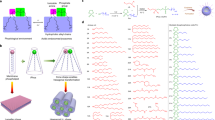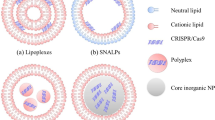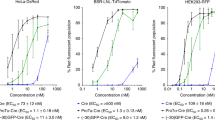Abstract
A novel gene transfer system was developed by using liposomes modified with cetylated polyethylenimine (PEI, MW 600). This polycation liposome, PCL, showed remarkable transfection efficiency as monitored by the expression of the GFP reporter gene. Most conventional cationic liposomes require phosphatidylethanolamine or cholesterol as a component, although PCLs did not. Egg yolk phosphatidylcholine- and dipalmitoylphosphatidylcholine-based PCL were as effective as dioleoylphosphatidylethanolamine-based PCLs for gene transfer. Concerning the cytotoxicity against COS-1 cells and hemolytic activity, the PCL was superior to conventional cationic liposome preparations. Furthermore, the transfection efficacy of PCLs was enhanced, instead of being diminished, in the presence of serum. Effective gene transfer was observed in all eight malignant and two normal cells line tested, as well as in COS-1 cells. We also examined the effect of the molecular weight of PEI on PCL-mediated gene transfer, and observed that PEI with a MW of 1800 Da was as effective as that with one of 600, but that PEI of 25 000 was far less effective. Finally, an in vivo study was done in which GFP was effectively expressed in mouse liver after injection of PCL via the portal vein. Thus, PCL represents a new system useful for transfection and gene therapy.
This is a preview of subscription content, access via your institution
Access options
Subscribe to this journal
Receive 12 print issues and online access
$259.00 per year
only $21.58 per issue
Buy this article
- Purchase on Springer Link
- Instant access to full article PDF
Prices may be subject to local taxes which are calculated during checkout







Similar content being viewed by others
References
Kay MA, Liu D, Hoogerbrugge PM . Gene therapy Proc Natl Acad Sci USA 1997 94: 12744–12746
Anderson WF . Human gene therapy Nature 1998 392: 25–30
Verma IM, Somia N . Gene therapy – promises, problems and prospects Nature 1997 389: 239–242
Jooss K, Yang Y, Fisher KJ, Wilson JM . Transduction of dendritic cells by DNA viral vectors directs the immune response to transgene products in muscle fibers J Virol 1998 72: 4212–4223
Fisher KJ et al. Recombinant adeno-associated virus for muscle directed gene therapy Nature Med 1997 3: 306–312
Gao X, Huang L . Cationic liposome-mediated gene transfer Gene Therapy 1995 2: 710–722
Meyer O et al. Cationic liposomes coated with polyethylene glycol as carriers for oligonucleotides J Biol Chem 1998 273: 15621–15627
Behr JP . Gene transfer with synthetic cationic amphiphiles. Prospects for gene therapy Bioconj Chem 1994 5: 382–389
Vigneron JP et al. Guanidinium-cholesterol cationic lipids: efficient vectors for the transfection of eukaryotic cells Proc Natl Acad Sci USA 1996 93: 9682–9686
Wrobell I, Collins D . Fusion of cationic liposomes with mammalian cells occurs after endocytosis Biochem Biophys Acta 1995 1235: 296–304
Cortesi R et al. Effect of cationic liposome composition on in vitro cytotoxicity and protective effect on carried DNA Int J Pharm 1996 139: 69–78
Boussif O et al. A versatile vector for gene and oligonucleotide transfer into cells in culture and in vivo: polyethylenimine Proc Natl Acad Sci USA 1995 92: 7297–7301
Abdallah B et al. A powerful nonviral vector for in vivo gene transfer into the adult mammalian brain: polyethylenimine Hum Gene Ther 1996 7: 1947–1954
Lambert RC et al. Polyethylenimine-mediated DNA transfection of peripheral and central neurons in primary culture. Probing Ca2+ channel structure and function with antisense oligonucleotides Mol Cell Neurosci 1996 7: 239–246
Zanta MA, Boussif O, Adib A, Behr JP . In vitro gene delivery to hepatocytes with galactosylated polyethylenimine Bioconj Chem 1997 8: 839–844
Kircheis R et al. Coupling of cell-binding ligands to polyethylenimine for targeted gene delivery Gene Therapy 1997 4: 409–418
Tang MX, Szoka FC . The influence of polymer structure on the interactions of cationic polymers with DNA and morphology of the resulting complexes Gene Therapy 1997 4: 823–832
Boletta A et al. Nonviral gene delivery to the rat kidney with polyethylenimine Hum Gene Ther 1997 8: 1243–1251
Ferrari S et al. Exgen 500 is an efficient vector for gene delivery to lung epithelial cells in vitro and in vivo Gene Therapy 1997 4: 1100–1106
Pollard H et al. Polyethylenimine but not cationic lipids promotes transgene delivery to the nucleus in mammalian cells J Biol Chem 1998 273: 7507–7511
Oku N et al. Low pH induced membrane fusion of lipid vesicles containing proton-sensitive polymer Biochemistry 1987 26: 8145–8150
Hofland HEJ, Shephard L, Sullivan SM . Formation of stable cationic lipid/DNA complexes for gene transfer Proc Natl Acad Sci USA 1996 93: 7305–7309
Escriou V et al. Cationic lipid-mediated gene transfer. Effect of serum on cellular uptake and intracellular fate of lipopolyamine/DNA complexes Biochem Biophys Acta 1998 1368: 276–288
Sternberg B, Hong K, Zheng W, Papahadjopoulos D . Ultrastructural characterization of cationic liposome-DNA complexes showing enhanced stability in serum and high transfection activity in vivo Biochem Biophys Acta 1998 1375: 23–35
Kichler A, Mechtler K, Behr JP, Wagner E . Influence of membrane-active peptide on lipospermine/DNA complex mediated gene transfer Bioconj Chem 1997 8: 213–221
Zhou X, Klibanov AL, Huang L . Lipophilic polylysines mediate efficient DNA transfection in mammalian cells Biochem Biophys Acta 1991 1065: 8–14
Sorgi FL, Bhattacharya S, Huang L . Protamine sulfate enhances lipid-mediated gene transfer Gene Therapy 1997 4: 961–968
Goldman CK et al. In vitro and in vivo gene delivery mediated by a synthetic polycationic amino polymer Nat Biotechnol 1997 15: 462–466
Zhou X, Huang L . DNA transfection mediated by cationic liposomes containing lipopolylysine. Characterization and mechanism of action Biochem Biophys Acta 1994 1189: 195–203
Plank C et al. The influence of endosome-disruptive peptides on gene transfer using synthetic virus-like gene transfer systems J Biol Chem 1994 269: 12918–12924
Felnger JH et al. Enhanced gene delivery and mechanism studies with a novel series of cationic lipid formulations J Biol Chem 1994 269: 2550–2561
Xu Y, Szoka FC Jr . Mechanism of DNA release from cationic liposome/DNA complexes used in cell transfection Biochemistry 1996 35: 5615–5623
Farhood H, Serbina N, Huang L . The role of dioleoylphosphatidyl-ethanolamine in cationic liposome mediated gene transfer Biochem Biophys Acta 1995 1235: 289–295
Reimer DL et al. Formation of novel hydrophobic complexes between cationic lipid and plasmid DNA Biochemistry 1995 39: 12877–12883
Hui SW et al. The role of helper lipid in cationic liposome-mediated gene transfer Biophys J 1996 71: 590–599
Bailey AL, Cullis PR . Membrane fusion with cationic liposomes. Effect of target membrane lipid composition Biochemistry 1997 36: 1628–1634
Noguchi A, Furuno T, Kawaura C, Nakanishi M . Membrane fusion plays an important role in gene transfection mediated by cationic liposomes FEBS Lett 1998 433: 169–173
Demeneix BA, Behr JP . The proton sponge. A trick the viruses did not exploit. In: Felgner PL et al (eds) Artificial Self-Assembling Systems for Gene Delivery ACS Conference Proc 1996 pp 146–151
Cheng PW . Receptor ligand-facilitated gene transfer enhancement of liposome-mediated gene transfer and expression by transfection Hum Gene Ther 1996 7: 275–282
Harbottle RP et al. An RGD-oligolysine peptide. A prototype construct for integrin-mediated gene delivery Hum Gene Ther 1998 9: 1037–1047
Acknowledgements
We thank Drs K Takeda and H Miyazaki and Mr Y Suzuki at DNAVEC Research, for their helpful discussions; Mr T Iwasaki and Mr H Ori for technical assistance, and Dr Y Sadzuka of the University of Shizuoka for measurement of ζ-potentials. We also thank Dr Y Namba at Nippon Fine Chemical for the supply of phospholipids.
Author information
Authors and Affiliations
Rights and permissions
About this article
Cite this article
Yamazaki, Y., Nango, M., Matsuura, M. et al. Polycation liposomes, a novel nonviral gene transfer system, constructed from cetylated polyethylenimine. Gene Ther 7, 1148–1155 (2000). https://doi.org/10.1038/sj.gt.3301217
Received:
Accepted:
Published:
Issue Date:
DOI: https://doi.org/10.1038/sj.gt.3301217
Keywords
This article is cited by
-
Overcoming the non-kinetic activity of EGFR1 using multi-functionalized mesoporous silica nanocarrier for in vitro delivery of siRNA
Scientific Reports (2022)
-
Efficient access to aliphatic esters by photocatalyzed alkoxycarbonylation of alkenes with alkyloxalyl chlorides
Nature Communications (2021)
-
Nanostructured hydrophobic polyampholytes: self-assembly, stimuli-sensitivity, and application
Advanced Composites and Hybrid Materials (2018)
-
Phase-Separated Liposomes Enhance the Efficiency of Macromolecular Delivery to the Cellular Cytoplasm
Cellular and Molecular Bioengineering (2017)
-
Cationic microRNA-delivering nanocarriers for efficient treatment of colon carcinoma in xenograft model
Gene Therapy (2016)



